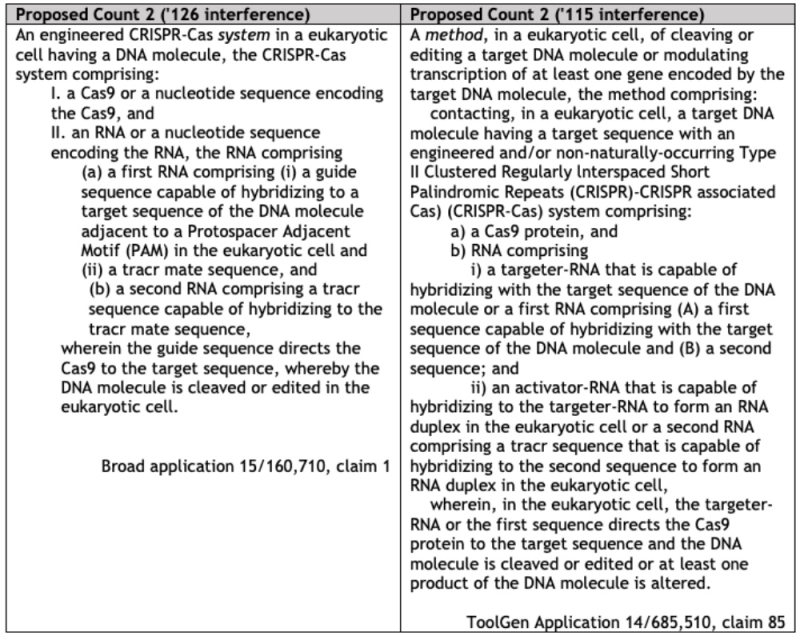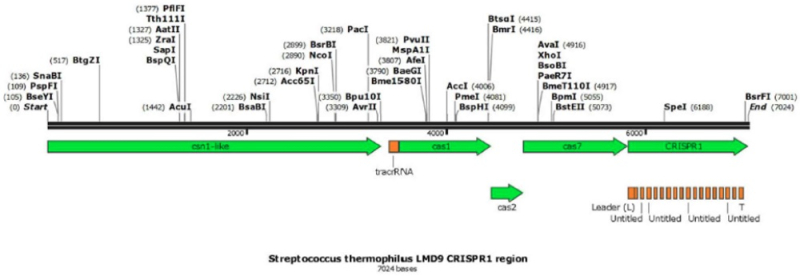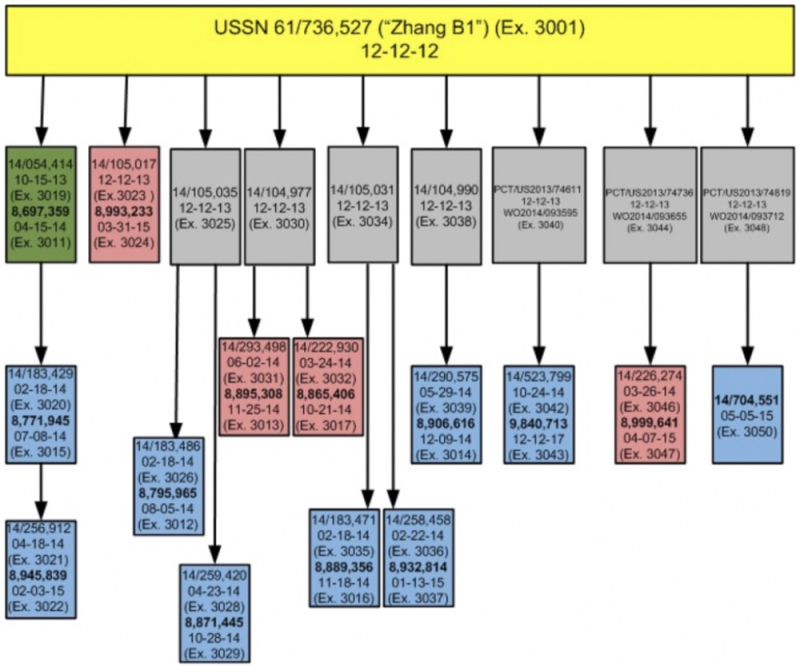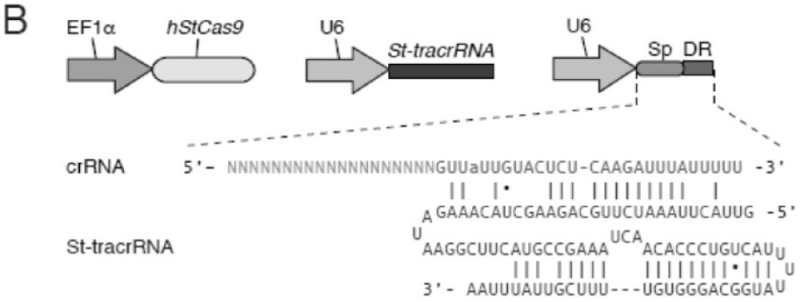On May 28th, Junior Party the Broad Institute, Harvard University, and MIT (collectively, "Broad") filed its Substantive Preliminary Motion No. 1 in CRISPR Interference No. 106,126 (where ToolGen is the Senior Party). While this Motion shares many similarities to a similar motion filed in Broad's interference against the University of California, Berkeley, the University of Vienna, and Emmanuelle Charpentier; Junior Party and collectively, "CVC"), there are significant differences in the proposed Count 2 in this interference and the proposed Count 2 proposed in the '115 Interference (wherein the Board denied Broad's motion in that interference).
Broad filed this motion pursuant to 37 C.F.R. §§ 41.121(a)(1)(iii) and 41.208(a)(1). The two proposed Counts 2 are set forth as follows:

Broad's argument, as it was unsuccessfully in the '115 interference, is that it would be unfair to preclude them from establishing conception of the "genus" of eukaryotic CRISPR claims by limiting the Count to sgRNA species (which here as in the '115 interference would be subject to CVC's arguments of prior conception), an argument the motion asserts is "consistent with Broad's proofs in [the '115 interference]" (see "CRISPR Motions Day at the PTAB: Broad Files Its Substantive Motion No. 2").
Broad further argues in the unfairness vein that losing this interference would invalidate its generic claims and could raise interference estoppel against the Party for claims reciting dual-molecule embodiments pursuant to MPEP § 2308.03.
As known from Broad's priority position in the '115 interference, they have asserted conception (at least) of dual-molecule embodiments prior to CVC's disclosure of single-molecule CRISPR configurations (which are the subject of CVC's claims that Broad had the benefit of communication from Dr. Marraffini and thus Broad should not be credited with conception thereof; see "CVC Files Reply to Broad's Opposition to CVC's Priority Motion"). Broad further argues that:
In this regard, it does not matter if Broad has only one involved claim directed to generic RNA systems or many such claims. With even one of Broad's generic RNA claims involved in a priority contest based on the species of Count 1, an adverse ruling could wholesale deprive Broad of the ability to claim the generic RNA system as its invention, including future claims that Broad might prosecute.
Unlike in the '115 Interference, Broad here asserts that opponent (and Senior Party) ToolGen has itself pursued claims generic to the configuration of the RNA species. Accordingly, Broad contends that "because both parties have laid claim to the eukaryotic invention regardless of whether dual-molecule RNA or single-molecule RNA is used, adopting a generic RNA count, Proposed Count 2, is the most just resolution, and the one that will properly reflect the full scope of the interfering subject matter."
In addition, Broad asks the Board to give them priority benefit to U.S. provisional application No. 61/736,527, filed December 12, 2012, reminding the Board that it conferred priority benefit to this application in the '115 interference which was limited to Count 1. Finally, the motion asks the Board to designate the following claims as corresponding to Count 2 should the Board grant Broad's Substantive Motion No. 1:
[C]laims 15-20 of the '359 patent[,] claims 26-29 of the '945 patent, claims 26-30 of the '965 patent, claims 24-30 of the '356 patent, all claims 1-30 of the '616 patent, claims 21-28 of the '839 patent, and claims 15-17, 20-24, 26-28, 31-35, and 38-39 of the '713 patent, and, upon the grant of Broad Contingent Motion 2, claims 1, 40, and 41 of the '710 application and claims 74, 94, and 95 of the '260 application [reference to exhibits excluded].
In addition, Broad asks the Board to designate all ToolGen claims as corresponding to Count 2 on the basis that the '126 Interference as declare designated these claims to correspond to "narrower" Count 1.
As Broad had done as Senior Party in the '115 Interference, here they argue that the two different embodiments of the CRISPR invention, citing ToolGen's U.S. Patent Application Publication No. 2015/0344912 for that proposition. Broad asserts that the two embodiments are "highly analogous" in eukaryotic cells, disregarding its rhetoric regarding how difficult eukaryotic CRISPR was to achieve (and the efficiencies introduced using sgRNA embodiments), citing experts (including CVC experts) in support of this proposition. The brief sets forth a timeline of its dual-molecule eukaryotic CRISPR experiments, using the following diagram to illustrate conception on April 5, 2011:

Broad asserts continued efforts for dual-molecule CRISPR in eukaryotic cells in August, 2011 (and reduction to practice in October-November 2011) and submission of an NIH grant on January 12, 2012 containing the following diagram of "an entire mammalian CRISPR expression system":

It was only after these efforts involving "already engineered and tested dual-molecule RNA CRISPR-Cas9 systems in eukaryotic cells" that Broad asserts Inventor Zhang "conceived of and by July 20, 2012 actually reduced to practice a single-molecule RNA system using a GAAA linker." The dual-molecule embodiments were first disclosed in a manuscript submitted on October 5, 2012 that published as the Le Cong et al. 2013 paper (Science 2013 Feb 15; 339:819-23), citing this passage:
To reconstitute the noncoding RNA components of the S. pyogenes type II CRISPR/Cas system, we expressed an 89-nucleotide (nt) tracrRNA (fig. S2) under the RNA polymerase III U6 promoter (Fig. 1B). Similarly, we used the U6 promoter to drive the expression of a pre-crRNA array comprising a single guide spacer flanked by DRs (Fig. 1B).
Broad contends that similar disclosure can be found in the Zhang B1 application, to which Broad asserts it is entitled with regard to this priority chain:

illustrated in a portion of Figure 11B in that application:

Despite these arguments, Broad concedes that the Board came to the conclusion that "guide" RNA in the context of the '115 Interference was limited to sgRNA species, a conclusion Broad continues in that interference and this to dispute according to Broad's brief (see "PTAB Decides Parties' Motions in CRISPR Interference").
Broad then sets forth certain claims in its involved patents and applications that encompass dual-molecule CRISPR embodiments (e.g., claim 15 of US Patent No. 9,840,713; the brief notes that claim 16 dependent in claim 15 in the '713 patent is limited to sgRNA species), and claims 1 and 2-24 of Broad's U.S. Patent No. 8,889,418, as well as Broad's involved U.S. Application Nos. 15/670,710 and 15/430,260 (which are the subject of Broad's Substantive Preliminary Motion No. 2, which will be the subject of a later post). The brief makes similar arguments with regard to the involved claims of U.S. Patent Nos. 8,697,359.
Broad exemplifies ToolGen's pursued claims "generic" to the RNA components of eukaryotic CRISPR, stating that the specification of ToolGen's involved '710 application recited the term "guide RNA" without restriction to sgRNA, and that "neither the involved ToolGen '510 application, nor any of the applications to which it claims priority, demonstrates or even suggests that single-molecule RNA is an improvement over dual-molecule RNA."
In explication of their argument, Broad expressly asserts it has been unfairly precluded from relying on some of the evidence set forth in this brief regarding conception and reduction to practice of dual-molecule CRISPR embodiments in the '115 Interference and asks the Board to avoid this consequence in this interference. ToolGen would not be prejudiced (except, of course, to the extent that granting Broad's motion would establish an earlier conception date followed by diligent reduction to practice of eukaryotic CRISPR by Broad) Broad contends because ToolGen has itself pursued dual-molecule CRISPR embodiments.